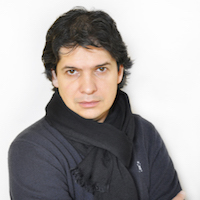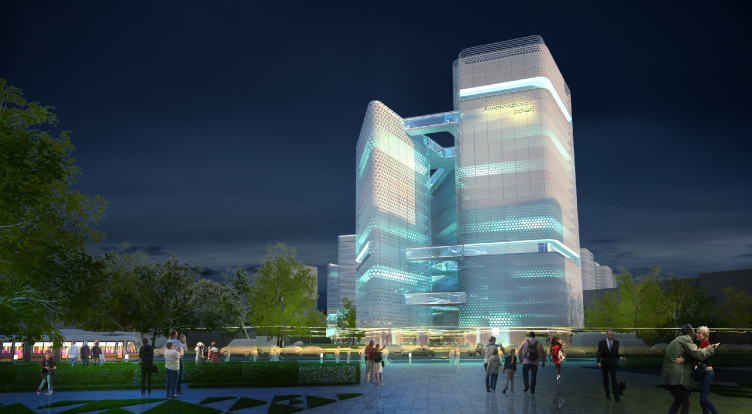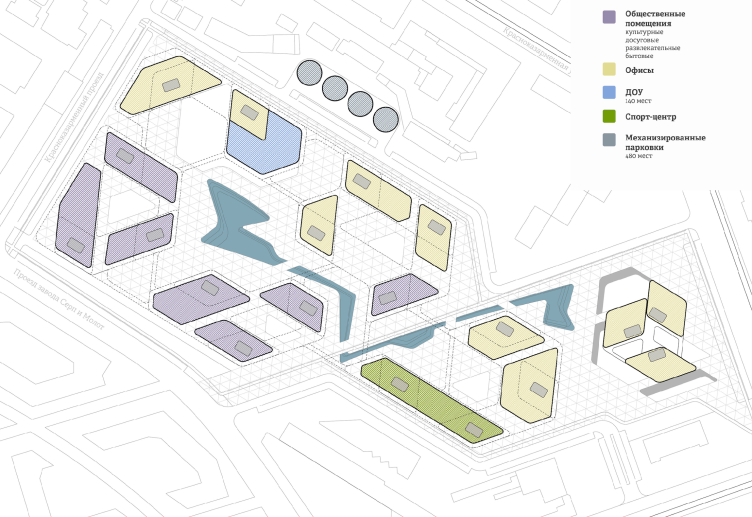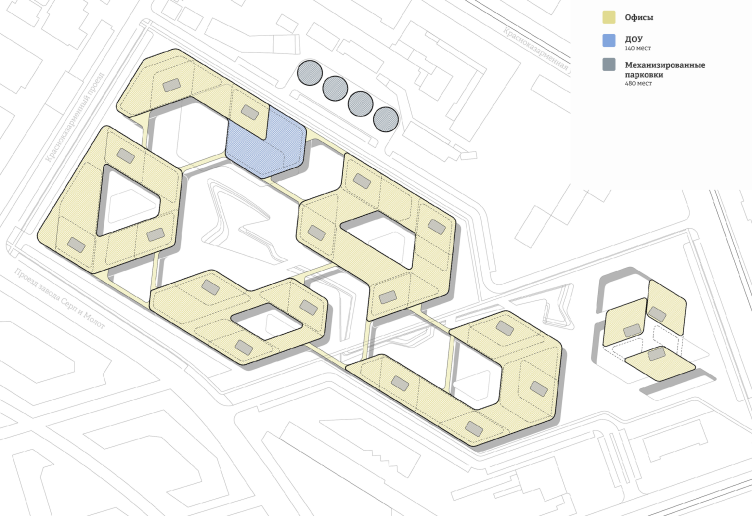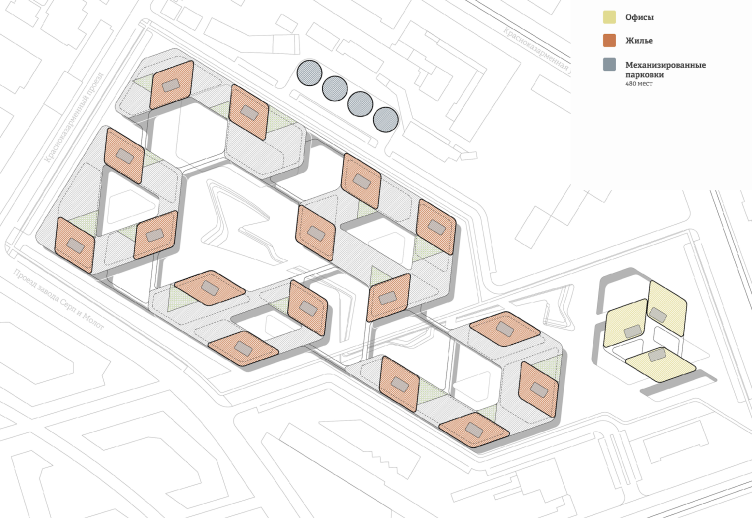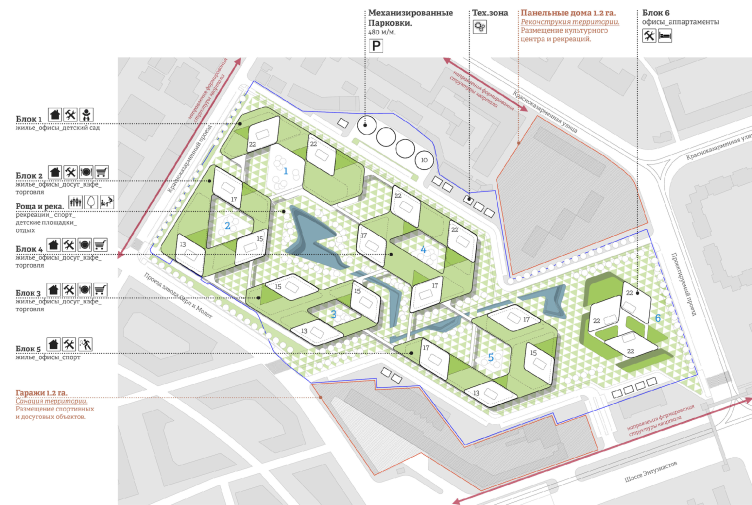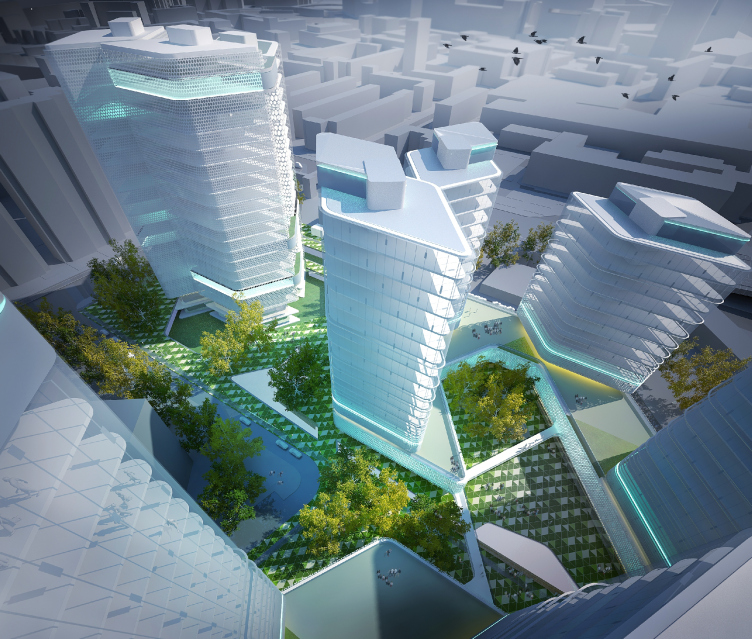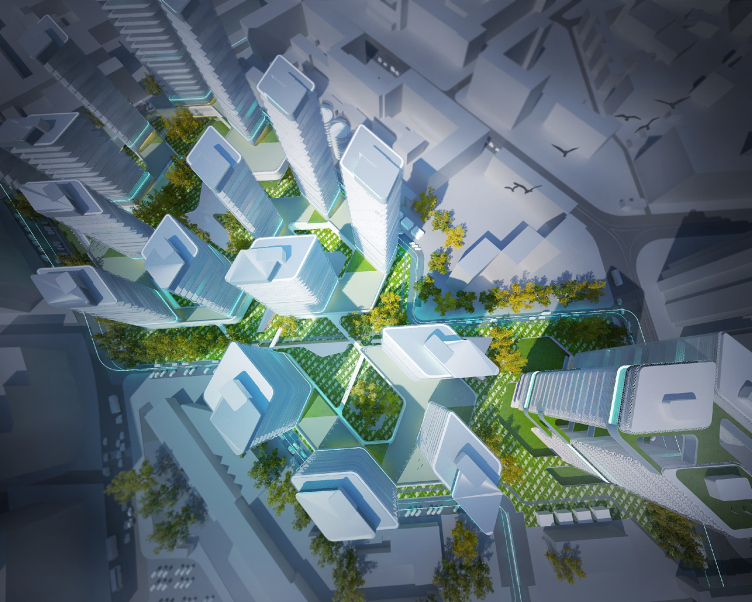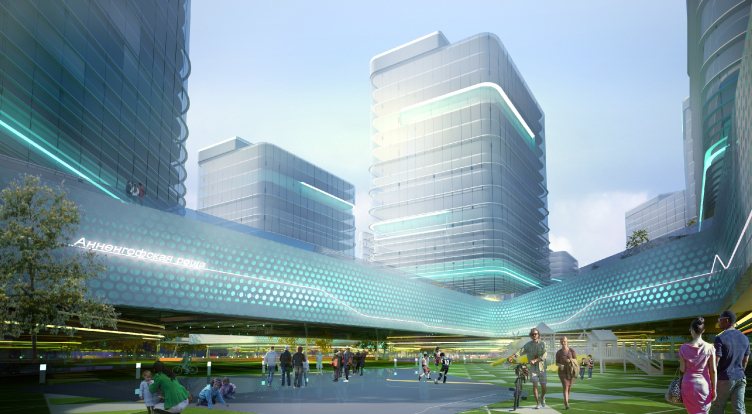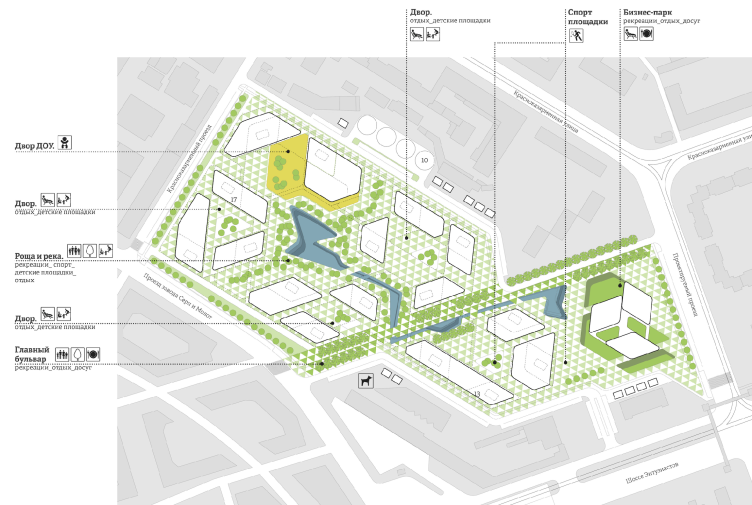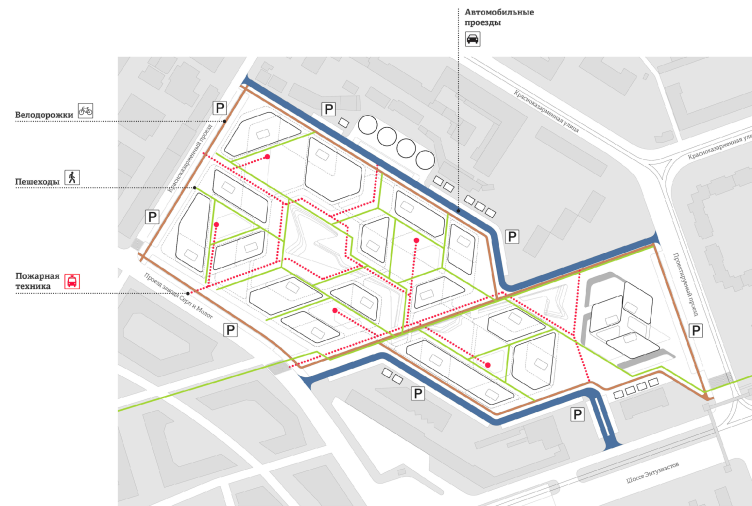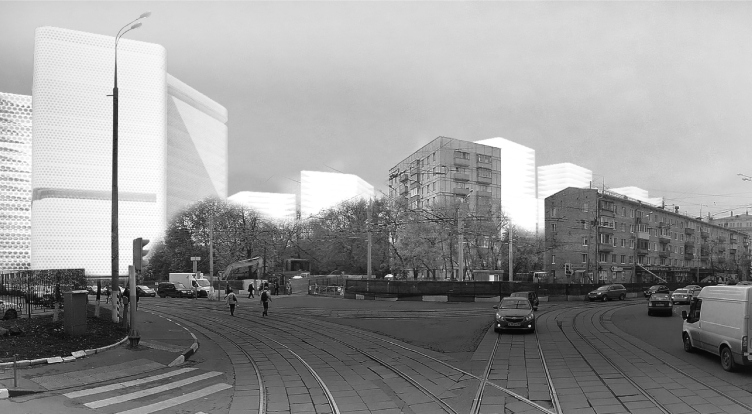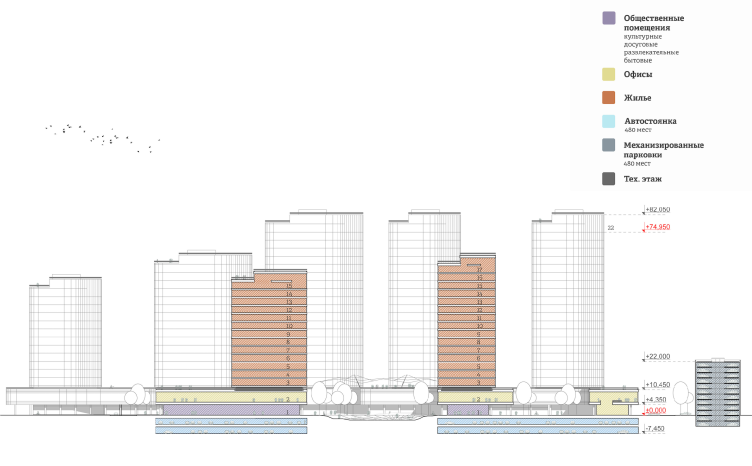The project of "Annenhof Grove" residential complex at the Krasnokazarmennaya Street © 4izmerenie
The project of "Annenhof Grove" residential complex at the Krasnokazarmennaya Street © 4izmerenie
Today, the district of Lefortovo – one of the oldest in Moscow – is being actively transformed. While today its industrial enterprises take up more than half of its territory, in the near future the proportion is to shift to the benefit of the residential, cultural and public spaces. Not so long ago, the angst over the plans to build up the “Hammer and Sickle” plant’s territory has calmed down, and in August 2014 “Morton” group announced a blitz-contest on a development draft for the neighboring lot that refers to “Tenancy 14” on the Krasnokazarmennaya Street. Following the results of the contest, the winners were awarded the first and the second prizes, while another eight works were short-listed (which means, under the terms of the contest, that they “can be invited to further creative competitions and projects of Morton group and OOO “Regional Urban Planning Center”). One of this Eight was the bureau “4izmerenie” with its project “Annenhof Grove”.
Since the existing buildings of this territory – production halls, warehouses and other objects of neither cultural nor architectural value – are not planned to be preserved, the only thing that limited the participants’ imagination was the design assignment itself. But they did have an interesting historical background at hand – the difficult fate of the Annenhof grove that has been here since the 1730’s. It is generally thought that the grove back in the day was planted overnight by a pleasing courtier Biron to delight the eyes of the empress Anna Ioannovna, never to be liked by the city people, and in the beginning of the last century was altogether “shaven” (Gilyarovsky) away by a massive tornado in 1904. The project of “4izmerenie” in a way aims to repair the historical injustice by giving a new life to the grove and a comfortable urban area with an open parking to the Muscovites. The team of “4izmerenie” feels right at home in this challenging and often-disliked mode of a blitz-contest. “It is like building parti diagram at the university – only now we do it for real, like the grownups that we are – says one of the project’s authors, Vsevolod Medvedev. – It is a great test for your speed of creative thinking and ability to make decisions quickly”. In this case it was actually a super-blitz – the task of the competition was completed in only five days, and the authors are happy with their result.
The project by “4izmerenie” fits into the spatial context as naturally as it does into the historical one. The master-plan of the development extends the main axes of the district. Their combination defined the rhomboidal cell structure of the plan divided into five mini-quarters plus the office-center, situated near the southern border. The architectures of “4izmerenie” consider this solution made entirely of advantages: it allowed them to create a fix and laconic composition with the residential, office and public volumes arranged along only three axes. The swiftly interchanging spaces, easy air-circulation, great insolation, the visual impression of constant movement (a definite advantage of this project, compared to some other short-listed participants, who consider building closed volumes with courtyards) – all of them are also functions of the multiply repeated rhombus, that represents a certain compromise between a canonical orthogonality a chaos of broken lines. The global practice actively uses this dynamic geometric figure in the area of façade decoration, however, it rarely puts it in a building plan – but if it does happen, it almost surely makes a powerful architectural expression: take, for instance, the centerpiece of Barcelona – “DiagonalZeroZero” upon the project of “EMBA” bureau, or Dominic Perro’s almost 1000 feet high “Blade” – that is now being built in Seoul.
All the buildings in the project “Annenhof Grove” are rhombuses with rounded corners that are almost identical in plan but have different numbers of floors (from 13 to 22 with the number of floors decreasing towards south) and oriented towards different cardinal directions, which allows avoiding monotony. The dwelling buildings “grow through” the stylobate that in its turn, according to Le Corbusier’s principle, appears to be hung over the ground floor, on the level of the second storey protecting from the rain and uniting the towers with square closed and semi-closed lines surrounding the inner yards. Thus, there forms a hybrid space on the ground floor: basically modernistic but with a hint of the traditional urban structure – more closed up, secluded, subdued to the human scale but not wind-blown like the usual micro-district. And up above – rise the towers. It creates an elegant compromise between the modern Moscow tendency to residential quarters and the insolation requirements. The play of the overhung horizontal connections between the towers is supported by the mounted passages, suggested be the architects of “4izmerenie”. These passages are laid along the lines of the rhombus-like module on the level of the fifth, ninth and twenty-first floors – a method not only striking and changing the whole development into a complex spatial construction, but also bold and pricy.
The project of "Annenhof Grove" residential complex at the Krasnokazarmennaya Street © 4izmerenie
The architects suggested making the most of the roofs of the stylobates operational: the planned recreational spaces are intended only for the dwellers of the district and local workers, unlike the lower level – available for everyone. The thing is, that unlike most participants of the contest that tended towards strict functional division of the corpuses into dwelling and office buildings, the architects of “4izmerenie” decided rather to approach this issue from two directions simultaneously. They suggested building the main office block on the crossroad of the Entuziastov highway and the future passway – first of all, it will create the architectural centerpiece from the direction of the main transport artery of the district, and secondly, it will provide an autonomous accessibility for the employees. Besides, the entire second level of the stylobate and partly the ground floors of the eastern towers are allocated for the offices (together with the commercial and public rooms).
This project owes its charming futuristic air not least to the facades solution – laconic, even minimalist “splendid snow-white icebergs” (in the metaphoric expression of Vsevolod Medvedev). The authors suggested making them of glass with insertions of metal – just think of the visual characteristics of the apartments! By the way, the apartment layouts promise to be interesting and various: the floor spaces of the apartments vary from 600 to 1600 ft2, plus the two-storey penthouses.
The project of "Annenhof Grove" residential complex at the Krasnokazarmennaya Street © 4izmerenie
The project of "Annenhof Grove" residential complex at the Krasnokazarmennaya Street © 4izmerenie
The project of "Annenhof Grove" residential complex at the Krasnokazarmennaya Street © 4izmerenie
The “not the most humane” building density, according to the architects, provided by the specifications (30 ha on a territory of 9 ha, aside from the underground space, with the height limitation of 240 ft) made the authors seek solutions of visual and dynamic lightening of the block. Since the ground floor development is not entire, but partial it allows for organizing a number of different well-equipped spaces, starting from little yards to squares that are to be open to all of the citizens according to the plan of the architects. And the central artery, extending the main axis of the neighboring site of the “Hammer and Sickle” (that is planned to be preserved after reconstruction) becomes the main planning accent of the block. This zone – practically a boulevard that organizes all the main fragments of the development – is planned to be completely pedestrian. More than that: the romantically-spirited architects have thought of an artificial little river as homage to Sinichka-river – that once flowed here, but now is only reminded of by several place-names. With a pinch of fantasy one can see the corpuses rising in different directions upon the stylobate not only as blocks of ice, but as some kind of a paraphrase of park trees. There should be plenty of real trees here, however: the architects want to make both the boulevard and the yards as green as possible. This is also a pendant of the “Hammer and Sickle” – its designer, “LPA Design” bureau, intends to make a city-park of it. A comfortable, ecological and simply good-looking recreational zone became one of the main advantages of this fascinating and promising project.



